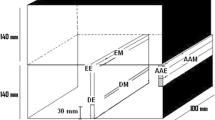Abstract
The present investigations were carried out on experimentally prepared AM50A and AZ91D alloys. The main thrust was the application of the Brightimeter technique in quantifying the concentration of the inclusions in these alloys. The results show that the Brightimeter indices are low when the amount of oxides, i.e., MgO, Al2O3, Al2MgO4 is high. Reducing the oxide concentration increases the Brightimeter readings (indices). It is concluded that the Brightimeter apparatus is an effective technique in determining the metal cleanliness in terms of detecting and measuring the inclusion content. Its sensitivity increases with the increase in the amount of inclusions. At low levels of inclusion concentration, there is a noticeable fluctuation in readings of the Brightimeter. The main parameter to be considered is the melting and solidification process. It is recommended that the Brightimeter readings (indices) should be coupled with metallographic examination. The main inclusions are magnesium oxides (MgO), magnesium hydroxides (Mg(OH)x), aluminum oxides (Al2O3), spinel (a mixture of MgO + Al2O3). In some cases, pure metals such as iron (Fe) and aluminum (Al) were also observed along with their oxides, i.e., FeO and Fe2O3. The use of flux as a protective agent may cause the presence of other types of inclusions such as K, Na and Ca. The quantity of oxides depends to a large extent on the inclusions initially present in the as-received alloy. Recycled alloys were found to contain the maximum amount of inclusions.






















Similar content being viewed by others
References
S.L. Sin, A. Elsayed, C. Ravindran, Inclusions in Magnesium and Its Alloys: A Review. Int. Mater. Rev. 58(7), 419–436 (2013)
B. Bronfin, N. Moscovitch, New Magnesium Alloys for Transmission Parts. Metal Sci. Heat Treat. 48, 479–486 (2006)
H. Hu, A. Luo, Inclusions in Molten Magnesium and Potential Assessment Techniques. JOM 48, 47–51 (1996)
M.J. Lessiter, W.M. Rasmussen, “To Pour or Not to Pour; The Dilemma of Assessing Your Aluminum Melt’s Cleanliness”, Mod. Cast., février, pp. 45–48 (1996)
A. Elsayed, E. Vandersluis, S. Lun Sin, C. Ravindran, “Inclusions in Permanent Mold Cast Magnesium ZE41A and AZ91D alloys”, Int. J. Metalcast., published on line, 07 December 2016
A.G. Haerle, R.W. Murray, W.E. Mercer II, B.A. Mikucki, A New Technique for Quantifying Non-metallic Inclusion Content in Magnesium. Light Metal Age 54, 1–10 (1996)
S. Housh, B. Mikucki, A. Stevenson, “Selection and Application of Magnesium and Magnesium Alloys”, in ASM Handbook, vol. 2—Properties and Selection: Nonferrous Alloys and Special-Purpose Materials, ASM International, Material Park, pp. 445–479 (1990)
Standard Specification for Magnesium Alloys in Ingot Form for Sand Castings, Permanent Mold Castings and Die Castings, ASTM B93/B93M-94B, Annual Book of ASTM Standards, Vol. 02, American Society for Testing and Materials, Philadelphia, PA, 1995
A. Stevenson, Melting the Aerospace Challenge with Magnesium Casting Alloys, in Light Metals 1987, ed. by R.D. Zabreznik (The Minerals, Metals & Materials Society, Warrendale, 1987), pp. 861–870
J.M. Tartaglia, J.C. Grebetz, Observations of Intermetallic Particle and Inclusion Distributions in Magnesium Alloys, in Magnesium Technology 2000, ed. by H.I. Kaplan, J. Hryn, B. Clow (The Minerals, Metals & Materials Society, Warrendale, 2000), pp. 113–121
J.C. Grebetz, Day, A.G. Haerle, “Qualification of Recycled Magnesium Type 1 Die Casting”, 55th IMA Annual World Magnesium Conference, Coronado, CA, pp. 8–15 (May 1998)
D. Oymo, D.O. Karlsen, P.M.D. Pinfold, T. Mellerud, O. Lie, Particle Removal in Pure Magnesium, in Light Metals 1994, ed. by U. Mannwieler (The Minerals, Metals and Materials Society, Warrendale, 1994), pp. 1017–1024
K. Kimura, K. Nishii, M. Kawarada, Recycling Magnesium Alloy Housing for Notebook Computers. Fujtisu Sci. Tech. J. 38, 102–111 (2002)
R.P. Jacques, R. DasGupta, A.G. Haerle, “Evaluation of Recycled AZ91D Magnesium Alloy for Steering Column Components”, SAE Technical Paper No. 970332, SAE Transactions, vol. 106, pp. 327–334 (1997)
H.J.T. Ellingham, Transactions and Communications. J. Soc. Chem. Ind. 63, 125 (1944)
P. Bakke, D.O. Karlsen, “Inclusion Assessment in Magnesium and Magnesium Base Alloys”, Characteristics and Applications of Magnesium in Automotive Design (SP-1250), SAE Technical Paper No. 970330, pp. 61–73 (1997)
Acknowledgements
The authors would like to thank Dr. Carlton Fuerst, Chief Scientist, General Motors Canada, for suggesting the topic of this study. The authors would also like to thank Amal Samuel for enhancing the quality of the images presented in the present article.
Author information
Authors and Affiliations
Corresponding author
Rights and permissions
About this article
Cite this article
Paradis, M., Samuel, A.M., Doty, H.W. et al. Inclusion Measurement and Identification in Mg-Based Alloys: Application of the Brightimeter Technique. Inter Metalcast 12, 2–19 (2018). https://doi.org/10.1007/s40962-016-0130-7
Published:
Issue Date:
DOI: https://doi.org/10.1007/s40962-016-0130-7




